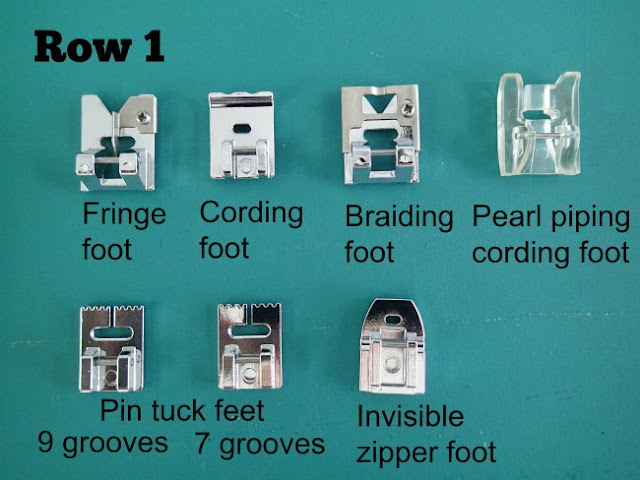Which sewing feet should you use and when/where?
The sewing machine presser foot is the small attachment that usually smoothies and flattens the fabric as it is fed through the machine and stitched. There are lots of different presser feet for all kinds of sewing jobs. You will probably never need to use them all.
your sewing machine's presser feet
On most modern machines you can change the foot with a simple lever which allows the presser feet to be easily released and changed. The presser foot attaches to the presser foot holder which is held onto the presser bar, usually with a small screw. You shouldn't need to remove the presser foot holder except for maintenance.
Choosing the correct sewing machine presser foot for the job!
Choosing the correct presser foot for your machine can make all the difference to a project, and it’s good to know which kind are available and their uses. Presser feet work in combination with a specific stitch or range of stitches, or manipulate the fabric to allow you to sew a specific technique.
Standard foot (A)
Every machine will come with a standard foot (also know as a zigzag foot). This foot has a pair of matching 'toes' either side of the needle. The standard foot will mainly be used for straight and zigzag stitching and some decorative stitches, depending on your brand of machine.
Regular zip foot (E)
This comes as standard with most machines and has openings on both sides, which allow you to sew near to a zip on each side. You must alter the position of the needle depending on which side of the foot you want to use. It can also be used to sew piping.
Quarter-inch seam foot (O)
This foot is indispensable to most quilters and dressmakers as it allows you to sew a perfect quarter-inch seam every time using the seam guide line duo along the edge of your fabric.
Walkingfoot
By using teeth similar to the feed dogs (found at the base of the machine that feed the fabric), this foot can also move the fabric from the top, making it great for thick, heavy fabric, or fabric that tends to stick. It’s also a quilter’s best friend!
Automatic buttonhole foot
Used in combination with your buttonholes stitches, this clever foot measures the button, which is inserted into the back section of the foot to create perfect buttonholes.
Darning, free machine or open toe foot
This is used mostly for free-machine sewing where the needles is used to create patterns and texture on fabric. It can also be used to top-stitch quilted projects. The feed dogs must be lowered to allow the fabric to move freely.
Piping or cording foot
With open grooves on the underside, the piping or cording is held in position and passes through the foot in a straight line, creating even stitching.
Satin foot (F)
Usually clear to aid visibility, and sometimes with an open toe, this foot is used for decorative and satin stitching as the foot allows a build up of stitches to be sewn on the fabric.
Teflon foot
Made using non-stick Teflon, to allow the foot to glide easily over laminated, vinyls, leather and suede, without the friction caused by a standard foot.
Blind Hem Foot (G)
Blind hemming can sometimes be a little bit tricky so the blind hem foot goes some way to helping improve this technique. The foot has a metal guide in the center and three grooves on the underside. During blind hemming, the fold of the fabric fits snugly against the fuide in the foot for accuracy wile the groove underneath help to prevent unnecessary slipping. The needle swings over the metal guide creating slack in the upper tension so that the pick of the stitch is almost invisible.
Pintucking Foot (T)
The pintucking foot is used with a 2mm twin needle to create multiple rows of pintucks. The grooves on the underside of the foot make it easy to stitch several rows parallel and evenly spaced from each other.
Ribbon / Sequin Foot (G)
As with beads and pearls it is now so much easier to attach ribbons and even sequins with the help of our special ribbon/sequin foot. This foot is designed with guides through which ribbon or strung sequins can be inserted and it will allow them to feed through evenly as you sew. Besides affixing the ribbon, a wide ladder stitch can be used with narrow ribbon to make an easy and functional drawstring.
AND MORE......
Top Tip!
Our top tip when you change your sewing machine's presser feet, is to put the foot you are taking off immediately back where it belongs. There's nothing quite so frustrating as wanting to sew up a zip and not being able to find the right foot in your sewing box!
Which sewing machine foot could you not live without?
Read about:
- WHAT DO YOU USE FOR TOY STUFFING?
- TIPS FOR STUFFING
Read more from: http://www.lovesewingmag.co.uk/
Visit my patterns shop: DIYSTUFFIES



















No comments:
Post a Comment